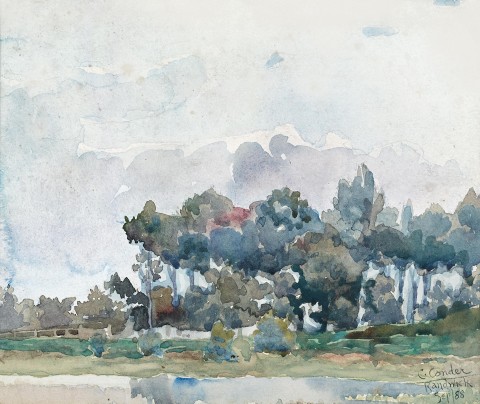RANDWICK, 1888
CHARLES CONDER
watercolour on paper
17.5 x 21.5 cm (sight)
signed, dated and inscribed with title lower right: C. Conder / Randwick / Sep / 88
John Young, Sydney
Barry Humphries, London
Piccadilly Gallery, London (label attached verso)
Thomas Agnew & Sons, London, purchased from the above November 1969 (label attached verso)
Sotheby’s, Melbourne, 29 May 1984, lot 35
Christopher Day Gallery, Sydney
Masterpiece Gallery, Hobart
Private collection, Queensland
Private collection, Hobart
Charles Conder: 1868 – 1890, Graves Art Gallery, Sheffield, 1 September – 1 October 1967, cat. 7, lent by Barry Humphries (label attached verso)
Hoff, U., Charles Conder, Lansdowne Press, Melbourne, 1972, cat. C33, p. 100
Rainy Day, 1888, oil on cedar cigar box lid, 12.0 x 19.0 cm, in the collection of the Art Gallery of New South Wales, Sydney (formerly in the collection of James Fairfax AC)
In the very month that Charles Conder painted this captivatingly aqueous watercolour, Randwick, 1888, the Trustees of the National Art Gallery of New South Wales purchased his masterpiece, Departure of the Orient – Circular Quay, 1888, then on show in the 9th Annual Exhibition of the Art Society of New South Wales. Singled out for praise in the press, it was one of ten works exhibited by Conder, leading to his recognition as a young artist of particular promise and one of the outstanding figures of Australian Impressionism. Acknowledging its purchase by the National Gallery, the critic for The Sydney Morning Herald described it as ‘one of the most character-marked pictures in the exhibition this year’.1 Also noted by the Illustrated Sydney News, Conder was acknowledged as a ‘rising young artist … represented by several smaller pictures, which show a wonderful conception of color and great boldness of treatment’.2 These included the classics Spring Time, 1888, purchased by the Felton Bequest for the National Gallery of Victoria in 1941, and An Early Taste for Literature, 1888, acquired by the Art Gallery of Ballarat, Victoria, in 1944.
As seen in Departure of the Orient – Circular Quay, Conder’s enthusiastic embrace of plein air painting, combined with an impressionist verve, gained much from the Italian-born Girolamo Nerli. Nerli, who moved to Sydney in 1887, had studied at the Accademia di Belle Arti, Florence, where teaching had been influenced by the Macchiaiaoli, said to have introduced plein air painting into Italy. Giovanni Fattori, Professor at the Accademia, for example, favoured painting outdoors on small panels, usually cigar boxes of unprimed wood.3 In Sydney there was also the teaching of A.J. Daplyn’s Saturday afternoon classes for the Art Society of New South Wales, and Julian Ashton’s evening sketch club, which Conder joined in 1888. It was a particularly important year for Conder’s development. During Easter he was at Coogee with Tom Roberts, each painting their own version of the seascape. In late July into August 1888 Conder joined Julian Ashton and A. H. Fullwood on a sketching holiday at Griffith’s Farm, Richmond, NSW, where their influences were more apparent in further classics such as Herrick’s Blossoms, 1888, in the National Gallery of Australia, Canberra, and The Farm Richmond, New South Wales, 1888, which was acquired by the National Gallery of Victoria. In October 1888 Conder moved to Melbourne to join Roberts and Arthur Streeton. What is held to be Conder’s finest Australian painting, A Holiday at Mentone, 1888 (Art Gallery of South Australia) was exhibited in the Victorian Artists’ Society Spring Exhibition of November.
The creative and technical brilliance of Conder’s 1888 winter masterpiece, Departure of the Orient – Circular Quay, was preceded by lively oil studies on cigar box lids. In February 1888, Rainy Day (Art Gallery of New South Wales) for example, had preceded in a masterly mood of dampness, and Bronte Beach, Queen’s Birthday, 1888 (D. R. Sheumack Collection), followed in September by our individual watercolour Randwick – the historic Chinese market gardens apart – the engaging landscape viewed almost entirely from an aesthetic point of view. Rapidly painted and composed from a slightly raised viewpoint, Randwick has that deftness which singles out the best of Conder’s work of this time.
1. ‘The Art Society’s Exhibition, The Sydney Morning Herald,18 September 1888, p. 5
2. ‘The Art Society’s Exhibition’, Illustrated Sydney News, 27 September 1888, p. 7
3. Galbally, A., Charles Conder, The Last Bohemian, The Miegunyah Press, Melbourne University Press, 2002, pp. 25-28
DAVID THOMAS
